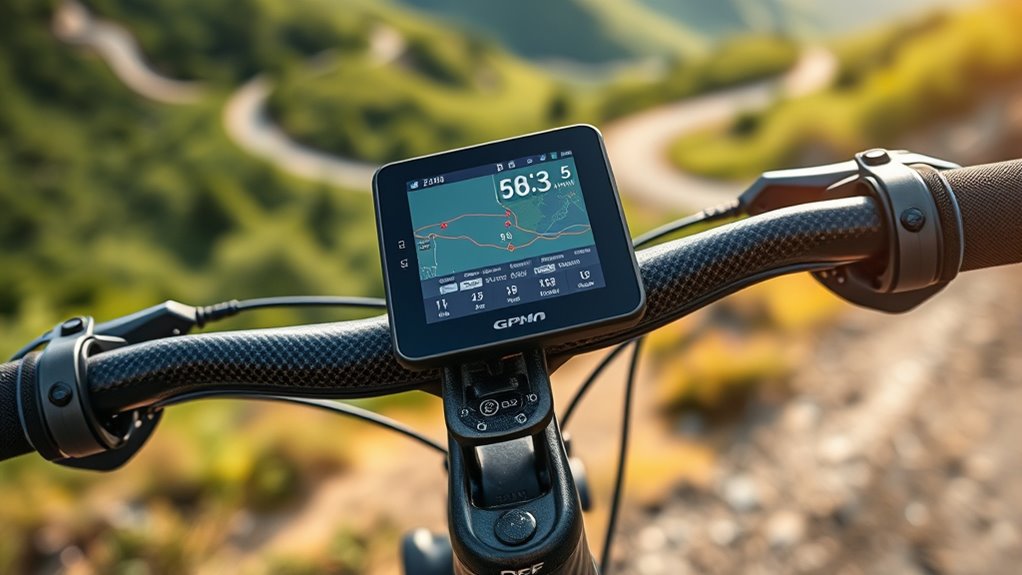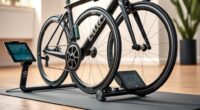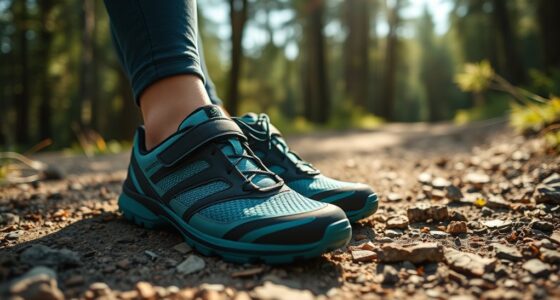Looking for the best GPS bike computers in 2025? I’ve tested options like Garmin Edge 530, Wahoo ELEMNT Bolt V2, and CYCPLUS for their performance, navigation, and durability. Each offers advanced features like route planning, sensor compatibility, and long battery life, helping you ride confidently. Whether you’re tracking stats or exploring new trails, these devices have something for every cyclist. Keep going, and you’ll find detailed insights to choose the perfect one for your rides.
Key Takeaways
- Top GPS bike computers in 2025 combine advanced navigation, accurate routing, and multi-satellite support for reliable off-road and urban navigation.
- Models offer comprehensive performance metrics, customizable data displays, and seamless sensor integration to enhance riding confidence.
- Durable, waterproof designs with long battery life ensure reliable operation in various weather conditions and extended rides.
- User-friendly interfaces, versatile mounting options, and compatibility with popular cycling platforms improve overall usability.
- The best devices provide real-time data, smart notifications, and support for route import/export, empowering cyclists to navigate confidently.
Garmin Edge 530 GPS Cycling Computer
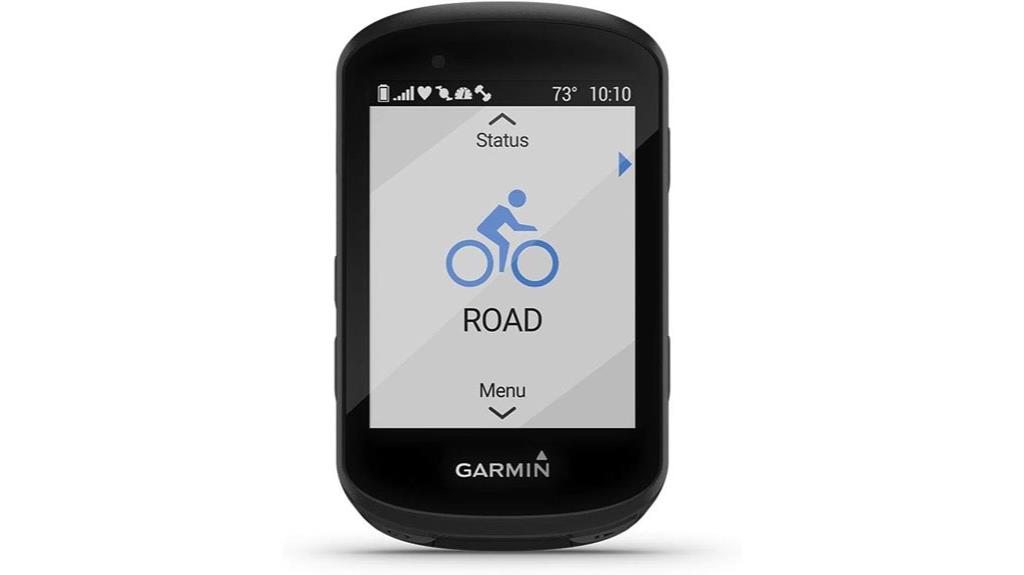
If you’re a serious cyclist seeking detailed performance analytics and reliable navigation, the Garmin Edge 530 is an excellent choice. It offers advanced mapping with routable Garmin Cycle Map, trail data, and off-course recalculation, perfect for mountain biking, gravel, or urban riding. The device tracks VO2 max, recovery, heat, altitude, and even MTB dynamics like jump count and Grit. Its button-controlled interface ensures easy operation, even with gloves. With up to 20 hours of battery life (extendable to 40), Bluetooth and Wi-Fi connectivity, and safety features like group messaging and radar compatibility, the Edge 530 is a thorough, dependable cycling companion.
Best For: serious cyclists and mountain bikers seeking advanced performance metrics, reliable navigation, and safety features for diverse riding environments.
Pros:
- Offers comprehensive performance analytics including VO2 max, recovery, Grit, and Flow metrics.
- Rugged, button-controlled design with long battery life up to 20 hours (extendable to 40 hours).
- Advanced mapping features with routable Garmin Cycle Map, trail data, and off-course recalculation.
Cons:
- No touchscreen, which may require a learning curve for some users.
- Mounting options may be limited for aero handlebars or specific bike setups.
- Visibility can be affected by mounting angle, sunlight, and lighting conditions, despite backlight support.
CYCPLUS GPS Bike Computer with Wireless Data Analysis
The CYCPLUS GPS Bike Computer stands out for its wireless data analysis, making it an excellent choice for cyclists who want accurate, real-time metrics without the hassle of tangled wires. Its high-sensitivity GPS tracks routes, ride time, distance, altitude, and other key stats with precision. The 2-inch LED display is clear even in sunlight, thanks to FSTN technology, and the device’s waterproof design guarantees durability. With a large 1200mAh battery lasting over 55 hours, it’s perfect for long rides. Compact and easy to mount, it offers simple controls, making data monitoring straightforward, even in challenging environments.
Best For: cyclists and outdoor enthusiasts seeking an affordable, easy-to-use GPS bike computer for accurate route tracking and ride metrics.
Pros:
- High-sensitivity GPS provides precise route, speed, and distance tracking
- Bright, clear LED display with automatic backlight for visibility in sunlight and low light conditions
- Long battery life of over 55 hours suitable for extended rides and multiple uses
Cons:
- Setup instructions, especially for timezone adjustment, may be unclear for some users
- Mounting stability can vary, with reports of mounts loosening over time
- GPS accuracy may decrease in tunnels, dense trees, or urban environments with obstructed sky view
Wahoo ELEMNT Bolt V2 GPS Cycling/Bike Computer, Black
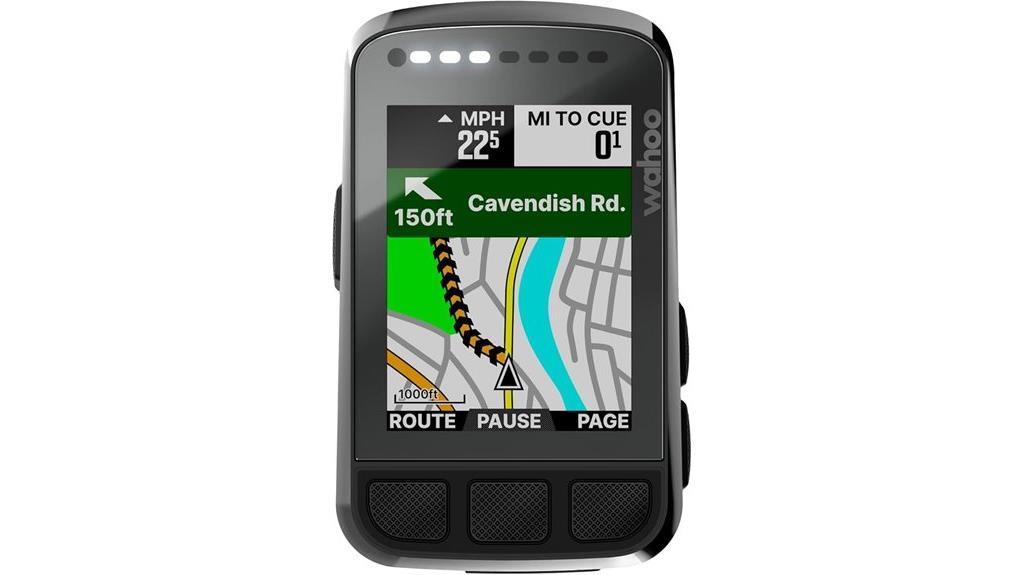
For serious cyclists seeking a streamlined and reliable GPS computer, the Wahoo ELEMNT Bolt V2 stands out with its sleek, aerodynamic design and intuitive interface. Its 2.2-inch, 64-color screen with ambient light sensors guarantees clear visibility in all lighting conditions. Compact yet sturdy, it’s easy to mount and customize with data pages, zoom, and LEDs. Supporting on-device navigation, it stores maps and routes for accurate directions, even in complex environments. Connectivity is seamless via Bluetooth, ANT+, and WiFi, with a 15-hour battery life. Users praise its ease of use, reliable GPS, and robust build, making it a top choice for focused cyclists.
Best For: serious cyclists who want a sleek, reliable, and highly customizable GPS cycling computer for navigation and performance tracking.
Pros:
- Easy to set up and intuitive to navigate, enhancing user experience.
- Bright, clear 2.2-inch color display with ambient light sensor for excellent visibility in all conditions.
- Robust build with seamless connectivity via Bluetooth, ANT+, and WiFi, plus a long battery life of around 15 hours.
Cons:
- Some users experience occasional slow sensor pairing or connectivity issues.
- Limited scrolling options on the interface may restrict quick navigation through menus.
- The screen can be difficult to see with sunglasses in very bright sunlight.
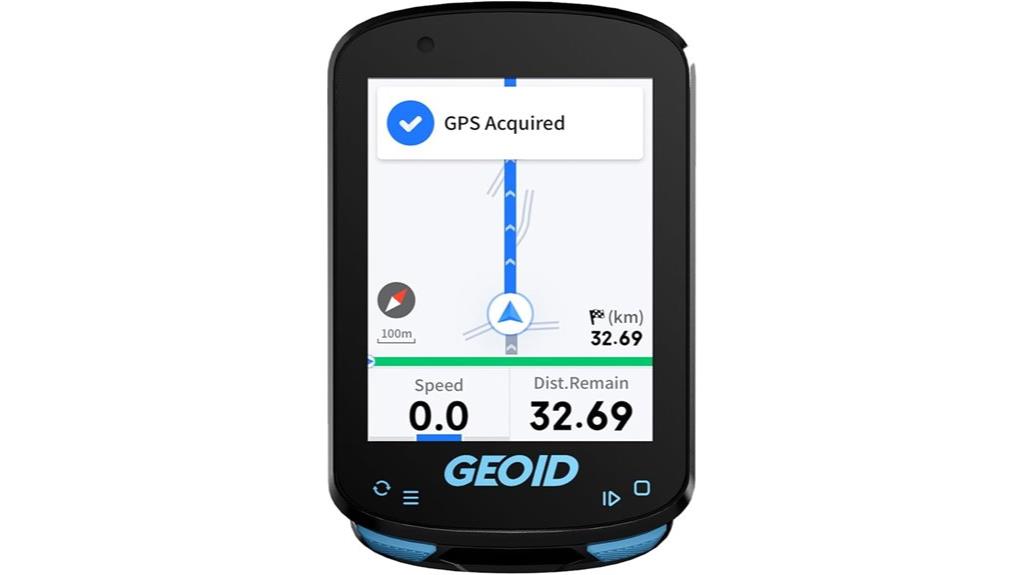
Cyclists seeking an affordable yet reliable GPS bike computer will find the CC600 to be an excellent choice. It features a durable 2.4-inch colorful display with bright visuals, even in sunlight, and an intuitive three-button interface. The device supports multiple satellite systems—GPS, BEIDOU, GLONASS, and more—for quick, accurate positioning. It offers turn-by-turn navigation, auto re-routing, and customizable data pages. With WiFi and Bluetooth, syncing ride data and firmware updates is seamless. Praised for its clarity and ease of use, the CC600 provides detailed metrics, making it ideal for both casual and intermediate cyclists without breaking the bank.
Best For: entry-level to intermediate cyclists seeking an affordable, reliable GPS bike computer with comprehensive navigation and performance tracking features.
Pros:
- Bright, colorful 2.4-inch display with excellent sunlight visibility
- Supports multiple satellite systems for fast, accurate positioning and navigation
- Seamless connectivity via WiFi and Bluetooth for easy data sync and updates
Cons:
- Initial setup may require calibration for speed sensors to ensure accuracy
- Limited customization options compared to higher-end models
- Slightly bulkier design may not appeal to all users seeking ultra-lightweight devices
iGPSPORT BSC100S GPS Bike Computer

If you’re seeking a budget-friendly GPS bike computer that doesn’t compromise on essential features, the iGPSPORT BSC100S stands out as an excellent choice. It sports a clear 2.6-inch LCD with high resolution, supports over 40 riding metrics like speed, distance, cadence, and temperature, and connects via GPS, Beidou, GLONASS, Galileo, and QZSS for fast, accurate positioning. Its lightweight design (67g) and IPX7 waterproof rating make it durable and comfortable. The device offers up to 40 hours of battery life, syncs seamlessly with sensors and apps like Strava, and operates with simple buttons. It’s perfect for casual riders who want reliable data without extra navigation features.
Best For: casual and community cyclists seeking an affordable, reliable GPS bike computer with essential tracking features and app connectivity.
Pros:
- Supports over 40 riding data points including speed, distance, cadence, and temperature for comprehensive metrics.
- Fast and accurate GPS positioning using multiple satellite systems (GPS, Beidou, GLONASS, Galileo, QZSS).
- Lightweight and durable with an IPX7 waterproof rating, making it suitable for various riding conditions.
Cons:
- Battery life may fall short of the advertised 40 hours, averaging around 20-25 hours in real-world use.
- Limited manual and app interface, with some users finding the setup and navigation process simplistic or slightly annoying.
- Lacks GPS navigation or map routing features, restricting route planning or turn-by-turn directions.
COOSPO Wireless GPS Bike Computer with Bluetooth and ANT
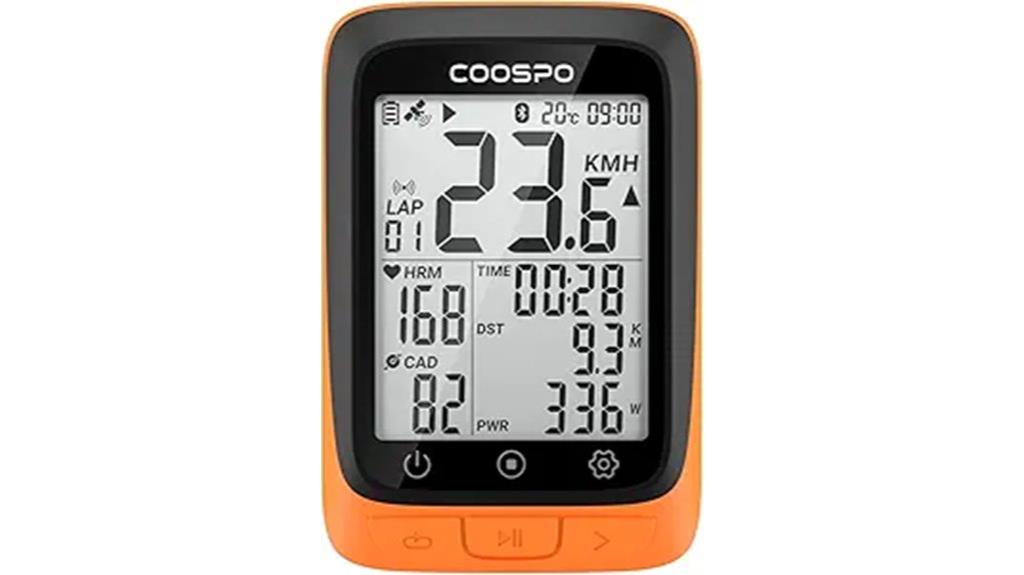
The COOSPO Wireless GPS Bike Computer with Bluetooth and ANT stands out for its dual-mode GPS and BeiDou positioning, delivering highly accurate location data even in challenging environments. Its compact, lightweight design features a 2.4-inch LCD display, housed in durable materials, and is waterproof (IP67 rated). It supports real-time metrics like speed, distance, temperature, and incline, with quick GPS connection and stable performance in dense cover. Though it’s compatible only with ANT+ sensors, users appreciate its ease of installation, long battery life, and clear display. However, some find programming and clock options limited, but overall, it offers great value for cyclists seeking reliable navigation.
Best For: cyclists who need a reliable, durable, and accurate GPS bike computer with easy installation and long battery life for outdoor riding in various weather conditions.
Pros:
- Accurate GPS and BeiDou dual-mode positioning for precise location data
- Compact, lightweight design with waterproof IP67 rating for durability in different weather conditions
- Easy to install handlebar mount and user-friendly interface with clear display
Cons:
- Limited to ANT+ sensors, with no Bluetooth sensor support for heart rate or cadence devices
- Some users experience slow GPS processing and difficulty programming the device
- Clock display options are restricted to only 24-hour format, with no 12-hour option
Garmin Edge 1040 GPS Bike Computer
https://m.media-amazon.com/images/I/618TymS1s9L.__AC_SX300_SY300_QL70_FMwebp_.jpg
Looking for a GPS bike computer that can handle tough terrains and provide precise navigation? The Garmin Edge 1040 is built for serious cyclists. It offers advanced multi-band GNSS technology, ensuring accurate positioning even in dense forests or challenging environments. Its bright, easy-to-read monochrome LCD makes navigation straightforward, and setup is simple. Compatible with multiple sensors like heart rate, power meters, and lights, it supports on and off-road riding. The battery lasts over two weeks, and the device withstands harsh weather conditions. Its safety features, like hazard detection and hill climb analysis, make it a top choice for confident cycling in any terrain.
Best For: serious cyclists and outdoor enthusiasts seeking a durable, high-accuracy GPS bike computer with advanced navigation and performance tracking features.
Pros:
- Exceptional multi-band GNSS technology ensures precise positioning even in dense forests or challenging environments
- Long battery life of over two weeks supports extensive training and outdoor rides
- User-friendly interface with bright, easy-to-read monochrome LCD and seamless sensor compatibility
Cons:
- Fragile glass screen may require protective case to prevent damage from drops
- Higher price point compared to other cycling computers, which may be a concern for budget-conscious users
- Slightly bulky profile may be less discreet or more cumbersome for some riders
COROS DURA Solar GPS Bike Computer
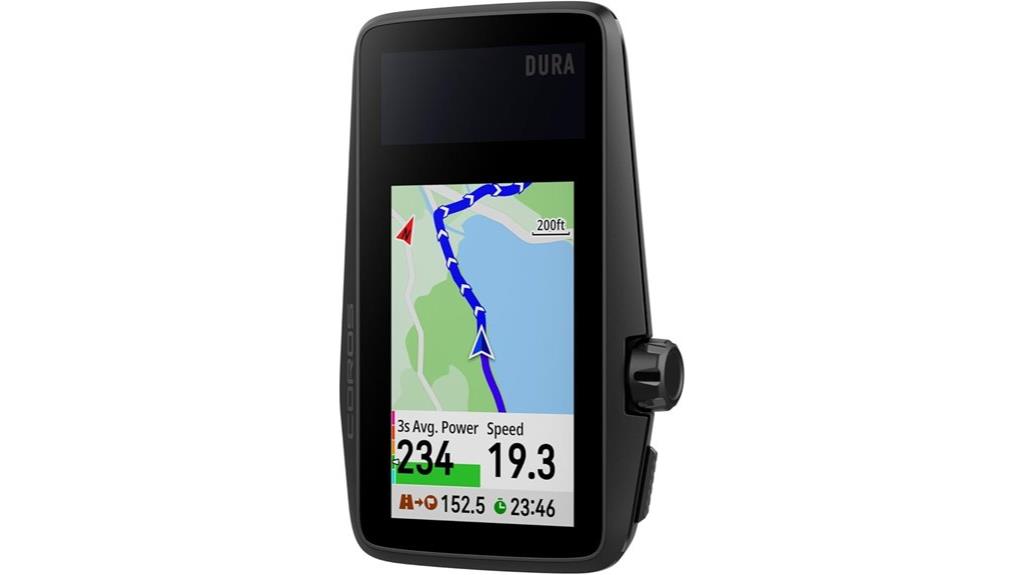
Cyclists seeking long-lasting battery life and reliable performance will find the COROS DURA Solar GPS Bike Computer a standout choice. Its impressive 120-hour GPS battery life, combined with solar charging that adds up to 2 hours per hour in direct sunlight, means you can ride for months without recharging. The 2.7-inch customizable color touchscreen offers clear data viewing even in bright sunlight, while adaptive backlighting guarantees visibility at night. With turn-by-turn navigation, smart rerouting, and compatibility with popular apps like Strava and Komoot, it’s perfect for navigation and fitness tracking alike. Tactile controls and weather-resistant features make it versatile for any riding condition.
Best For: cyclists who need a long-lasting, reliable GPS bike computer with advanced navigation and fitness tracking capabilities for extended rides and outdoor adventures.
Pros:
- Exceptional 120-hour battery life with solar charging extends usage in the field.
- Clear, customizable 2.7-inch touchscreen display visible in bright sunlight and at night.
- Supports seamless navigation with turn-by-turn directions and compatibility with popular apps like Strava and Komoot.
Cons:
- May be heavier or bulkier compared to smaller, minimalist bike computers.
- Limited advanced mapping features compared to dedicated GPS navigation devices.
- Relies on solar exposure for maximum battery efficiency, which could be less effective in shaded or cloudy conditions.
COOSPO Wireless Bike Computer GPS with ANT+ and Bluetooth
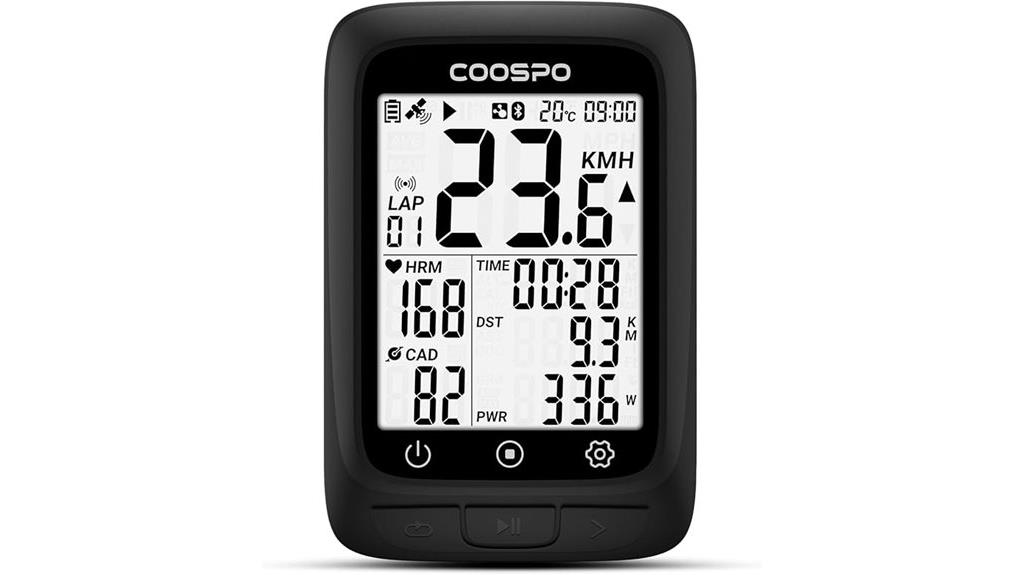
For budget-conscious riders seeking reliable GPS tracking, the COOSPO Wireless Bike Computer GPS with ANT+ and Bluetooth offers impressive features at an affordable price. It supports accurate GPS positioning with two modes and has a clear 2.4-inch LCD screen that’s easy to read in sunlight. Weighing just 100 grams, it boasts up to 80 hours of battery life, perfect for long rides. Its connectivity options include ANT+ and Bluetooth, allowing seamless pairing with heart rate monitors, sensors, and power meters. The device is waterproof (IP67), durable, and simple to install, making it a solid choice for casual and serious cyclists alike.
Best For: budget-conscious cyclists seeking reliable GPS tracking and sensor compatibility without sacrificing essential features.
Pros:
- Affordable price point offers great value for casual and serious riders
- Supports accurate GPS positioning with two modes and long battery life up to 80 hours
- Easy to install with multiple mounting options and seamless connectivity via ANT+ and Bluetooth
Cons:
- App interface can be less polished and may require some effort to navigate
- Some users report minor issues with sensor pairing and waterproofing over time
- Does not record total ride time, only active riding duration, which may be a limitation for some users
Garmin Edge 540 GPS Cycling Computer
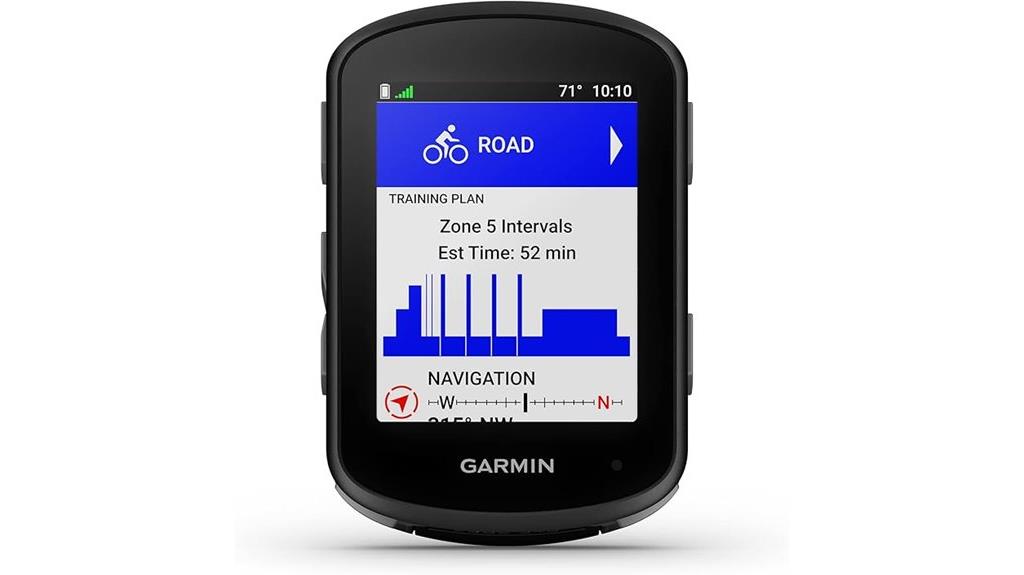
The Garmin Edge 540 stands out as an ideal choice for serious cyclists who need precise navigation and performance metrics. Its compact design packs a 2.6-inch high-resolution LCD that remains clear in bright sunlight, with button controls that work reliably in all conditions. Featuring multi-band GNSS technology, it offers pinpoint accuracy even in dense cover or urban areas. The device tracks key metrics, provides advanced features like ClimbPro, and delivers personalized training insights. With up to 26 hours of battery life, seamless sensor integration, and durable build quality, the Edge 540 is a dependable, feature-rich cycling companion for any rider aiming to elevate their performance.
Best For: Serious cyclists seeking precise navigation, detailed performance metrics, and durable, reliable hardware for road, trail, gravel, or indoor training.
Pros:
- Accurate multi-band GNSS technology ensures precise positioning even in challenging environments
- Long battery life of up to 26 hours supports extended rides without recharging
- User-friendly button controls that function reliably in all weather conditions
Cons:
- No touchscreen, which some users prefer for faster navigation and easier interface interaction
- Initial setup and mounting can be somewhat cumbersome for new users
- Slight lag in hill climb prompts may affect real-time responsiveness during climbs
iGPSPORT BSC300T Wireless Bike Computer with GPS and Touchscreen

If you’re seeking a bike computer that combines extensive navigation capabilities with user-friendly operation, the iGPSPORT BSC300T stands out. Its large 2.4-inch touchscreen, complemented by six buttons, makes it easy to navigate through various modes and data screens. It supports global satellite systems like GPS, Beidou, GLONASS, Galileo, and QZSS for fast, accurate positioning. You can download offline maps, save routes, and get turn-by-turn prompts worldwide. With over 130 data metrics, including speed, distance, and altitude, it offers detailed insights. Compatible with multiple bike types and multimedia devices, it’s perfect for riders seeking all-encompassing, reliable navigation and performance tracking.
Best For: cyclists who want a comprehensive, easy-to-use bike computer with advanced navigation, detailed performance metrics, and compatibility with various bike types and multimedia devices.
Pros:
- Large 2.4-inch touchscreen combined with six buttons for intuitive operation
- Supports multiple satellite systems (GPS, Beidou, GLONASS, Galileo, QZSS) for fast and accurate positioning
- Offers extensive data metrics (over 130) and offline map storage for detailed analysis and worldwide navigation
Cons:
- Might be complex for beginners due to the variety of features and settings
- Larger size may be less discreet or lightweight for some riders
- Dependence on battery life for prolonged rides could require frequent recharging
ROCKBROS GPS Bike Computer with Mount
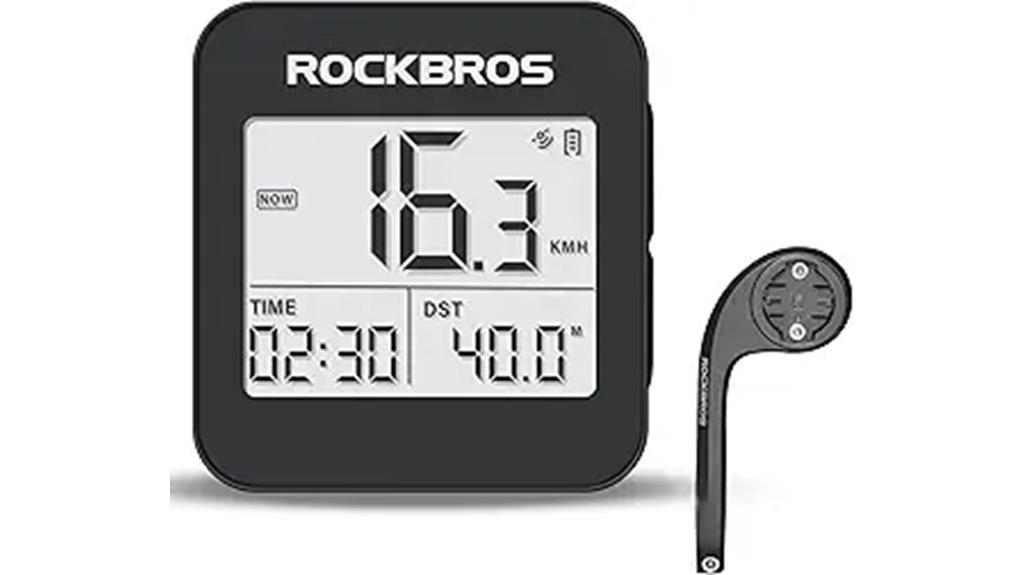
The ROCKBROS GPS Bike Computer with Mount stands out for cyclists who need quick, reliable GPS navigation without complex sensor setups. It supports all four major satellite systems, ensuring fast signal acquisition and high accuracy. The device displays essential ride data like time, distance, altitude, and total mileage on a clear 2-inch glare-free screen. Its IPX6 waterproof rating means it performs well in any weather. With a 600mAh battery lasting over 20 hours, and easy installation on various bikes and vehicles, it’s perfect for casual riders who want straightforward tracking without fuss. The simple interface and versatile mounting options make it a dependable choice.
Best For: casual cyclists and outdoor enthusiasts seeking a straightforward, reliable GPS bike computer with easy installation and weather resistance.
Pros:
- Supports all four major satellite systems for quick signal acquisition and high accuracy.
- Clear 2-inch glare-free LCD screen with backlighting, visible in sunlight and at night.
- IPX6 waterproof rating ensures durability and reliable operation in various weather conditions.
Cons:
- Initial GPS connection may take 3-5 minutes, which can be inconvenient.
- Some users experience inaccuracies or lag compared to sensor-based devices like Strava.
- Switching between KMH and MPH temporarily changes distance units to feet, which can be confusing.
CYCPLUS GPS Wireless Bike Computer

For cyclists seeking an affordable yet reliable GPS bike computer, the CYCPLUS GPS Wireless Bike Computer stands out with its impressive 1200mAh battery that offers over 60 hours of continuous use. Its 2.9-inch glare-free LCD screen, equipped with FSTN technology, ensures clear visibility in sunlight and switches to an automatic backlight for night riding. Built with durable tempered glass and a waterproof IPX6 rating, it handles rain and rough conditions easily. Equipped with Swiss high-sensitivity GPS, it delivers fast and accurate route tracking. Seamlessly syncing with the “CYCPLUS FIT” app via Bluetooth, it provides real-time data and supports multiple sensor integrations, making it a versatile choice for many cyclists.
Best For: cyclists seeking an affordable, reliable GPS bike computer with long battery life and easy app integration.
Pros:
- Long-lasting 1200mAh battery offers over 60 hours of use, ideal for long rides
- High-visibility 2.9-inch glare-free LCD screen with automatic backlight for day and night riding
- Durable construction with tempered glass and waterproof IPX6 rating for all weather conditions
Cons:
- Inconsistent sensor connection and occasional data inaccuracies, especially with temperature readings
- Fluctuating instantaneous speed due to GPS signal limitations during rides
- Limited customization options within the app and non-reconfigurable display layout
iGPSPORT BSC200S GPS Bike Computer with Wireless Navigation
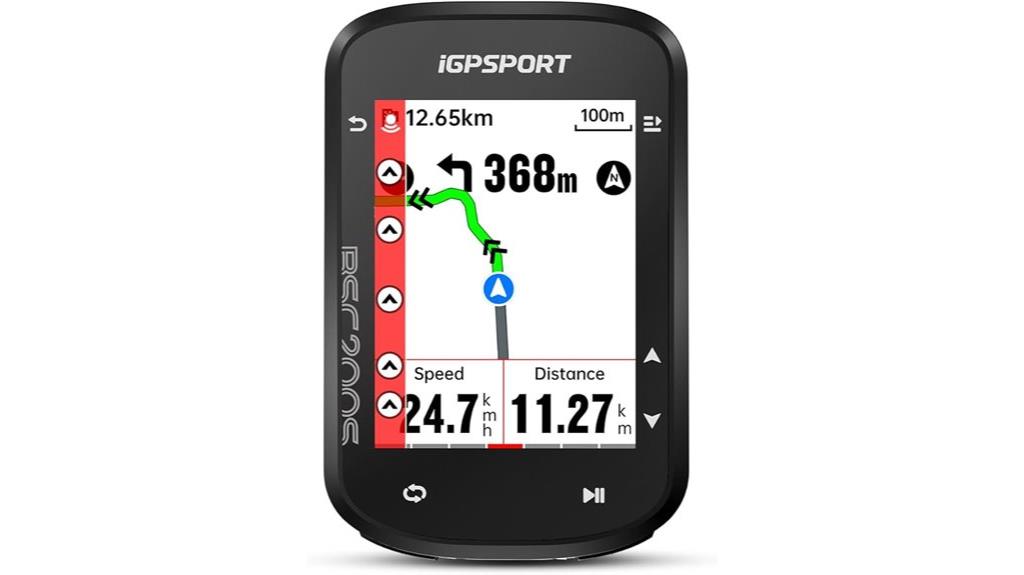
Designed for serious cyclists, the iGPSPORT BSC200S GPS bike computer stands out with its wireless navigation and seamless route import options. You can create routes through the official app or import from platforms like Strava, Ride with GPS, and Komoot. Customizable route colors and location points make navigation intuitive. One-touch route sending simplifies start-ups, while features like “Back to Start” keep you on track. It offers smart notifications, including call and message alerts, plus compatibility with lights and radar systems for safety. Its durable IPX7 waterproof design and long-lasting 25-hour battery guarantee dependable performance in all conditions.
Best For: serious cyclists seeking a reliable GPS bike computer with customizable navigation, smart notifications, and long battery life for demanding rides.
Pros:
- Seamless route creation and import from multiple platforms like Strava and Komoot for versatile navigation options
- Long-lasting 25-hour battery and IPX7 waterproof design ensure durability and extended use in various conditions
- Smart notifications and compatibility with lights and radar systems enhance safety and convenience during rides
Cons:
- The device’s advanced features may have a learning curve for new users
- Limited screen size might restrict detailed data visibility at a glance
- Higher price point compared to basic bike computers could be a consideration for budget-conscious users
CYCPLUS Bike Computer GPS Wireless with ANT+ and Bluetooth
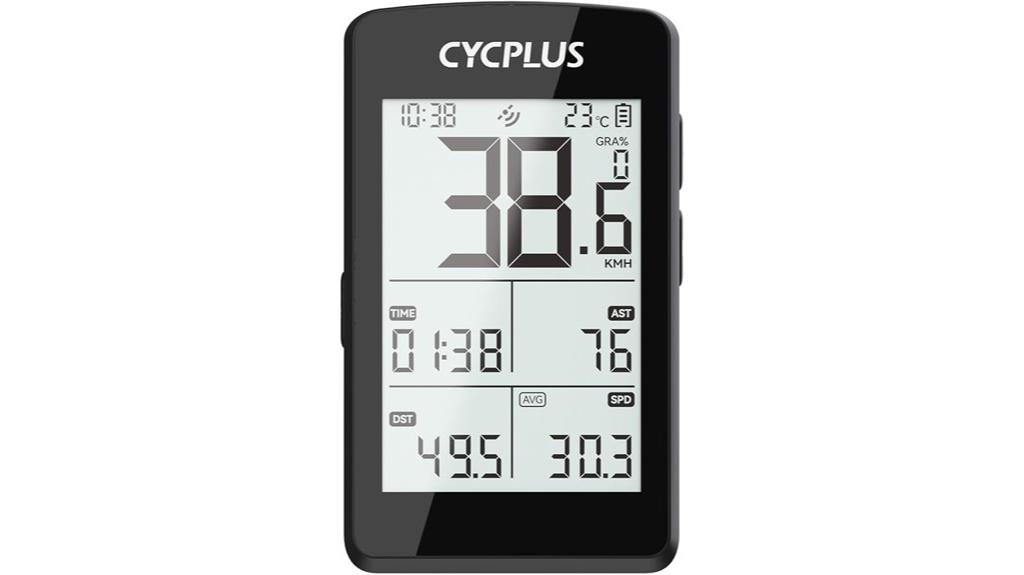
Cyclists seeking reliable, real-time tracking will appreciate the CYCPLUS Bike Computer’s rapid 10-second GPS positioning, which uses five satellite systems for quick and accurate location data. Initial fixes outdoors take just 3-5 minutes, but downloading offline ephemeris via the CYCPLUS FIT APP speeds this up. It supports ANT+ and Bluetooth, allowing seamless connection with sensors like speed, cadence, heart rate, and power. The 2.8-inch sunlight-readable LCD screen adjusts brightness automatically for clear viewing in all conditions. With a long-lasting 1500mAh battery providing up to 100 hours of use and IP67 waterproofing, it’s built to perform reliably on any ride.
Best For: Cyclists who need a reliable, long-lasting GPS bike computer with seamless sensor integration and clear visibility in all weather conditions.
Pros:
- Rapid 10-second GPS positioning using five satellite systems for accurate tracking
- Long battery life of up to 100 hours with quick USB-C charging
- Sunlight-readable 2.8-inch LCD screen with automatic backlight adjustment
Cons:
- Initial GPS fix outdoors may still take 3-5 minutes without offline ephemeris download
- Limited to a maximum of 8 customizable metrics per page, which may be restrictive for some users
- Requires smartphone app for offline ephemeris downloads and metric customization
Factors to Consider When Choosing GPS Bike Computers
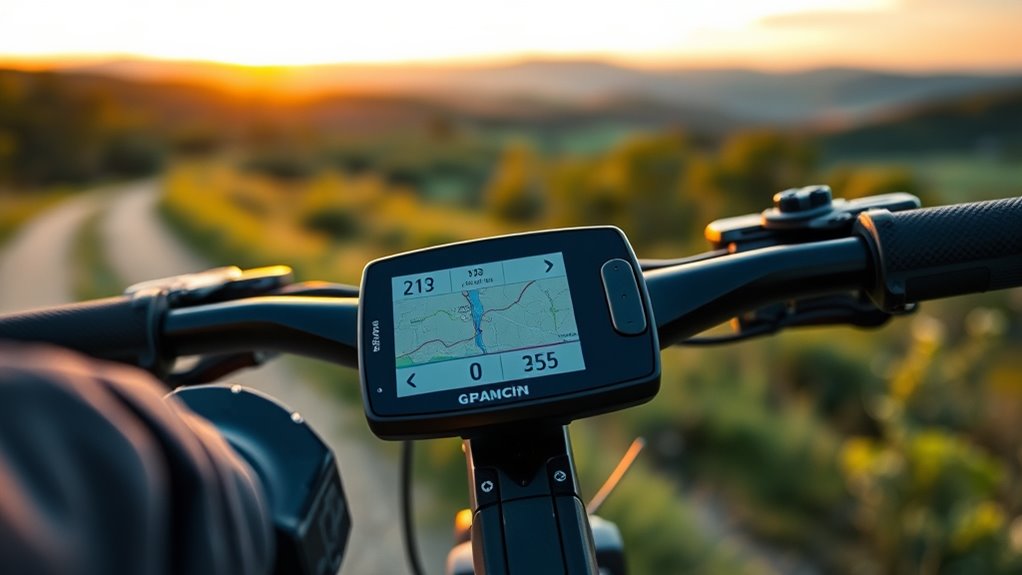
When choosing a GPS bike computer, I look at key factors like signal accuracy, screen visibility, and battery life to guarantee it meets my riding needs. Ease of use and sensor compatibility also play big roles in making a device reliable and convenient. Understanding these points helps me pick a model that keeps me confident on every ride.
GPS Accuracy and Signal
GPS accuracy and signal stability are crucial factors to consider when selecting a bike computer, as they directly impact your navigation and tracking reliability. The quality of the receiver, satellite system support, and environmental conditions all influence GPS performance. Multi-band GNSS technology, which uses signals from multiple satellite constellations like GPS, Beidou, GLONASS, Galileo, and QZSS, markedly improves positioning precision and reduces signal loss. However, environmental factors such as dense trees, tunnels, or tall buildings can weaken signals and cause inaccuracies. A quick satellite fix and consistent signal lock are indispensable for dependable real-time tracking. Choosing a device with robust multi-system support ensures you get accurate, stable signals even in challenging conditions, keeping your navigation dependable on every ride.
Screen Visibility and Size
A larger screen size makes it easier to view data fields at a glance, which is essential during rides. It allows for more information to be displayed clearly without crowding, so you can monitor speed, distance, and navigation effortlessly. Screen visibility also depends on the display technology; glare-resistant and backlit screens improve readability in bright sunlight or low-light conditions. Higher resolution screens show sharper text and detailed maps, enhancing overall clarity. Touchscreens are convenient but can be less responsive when wet or muddy, so button-operated models might be better for rugged conditions. Brightness and contrast levels are equally important; adjustable backlights and high-contrast screens ensure you can see your data clearly regardless of lighting environment. Choosing a device with superior screen visibility boosts confidence and safety on every ride.
Battery Life Duration
Battery life is a crucial factor to contemplate, especially for long rides or multi-day trips. Depending on the device, battery duration can range from 10 hours to over 100 hours, allowing for extended navigation without recharging. Devices with larger batteries or energy-efficient modes can support multiple long-distance rides or multi-day bikepacking adventures. Some models even feature solar charging, which can greatly extend battery life by harnessing sunlight during your ride. However, actual battery performance depends on usage patterns, such as GPS tracking frequency, backlight brightness, and connected sensors. To guarantee reliability, regular charging and proper device management are key. Choosing a GPS bike computer with sufficient battery life ensures you stay confident and connected during your entire ride.
Ease of Use Design
Choosing a bike computer that’s easy to operate can make a significant difference in your riding experience. An intuitive interface with simple controls, like buttons or touchscreens, helps you access data quickly without fuss. Clear, high-contrast displays with adjustable backlighting improve visibility in all lighting conditions, reducing strain on your eyes. A straightforward setup process, including quick sensor pairing and fast GPS lock, saves time and prevents frustration. Reliable physical controls that work well in rain or when wearing gloves are essential for consistent operation. Additionally, well-organized menus and customizable data screens let you access crucial information instantly, without digging through complex options. Overall, a user-friendly design ensures you stay focused on your ride, not on figuring out how your device works.
Sensor Compatibility Options
Ensuring your GPS bike computer can connect with your sensors is crucial for accurate ride data, so it’s important to verify compatibility with the sensors you use, like heart rate monitors, cadence sensors, or power meters. Many devices support Bluetooth, ANT+, or both, allowing flexibility with various sensor types. Check if the computer can connect to multiple sensors simultaneously, providing thorough insights during your ride. Compatibility with third-party sensors and platforms like Garmin, Wahoo, or Strava also streamlines data sharing. Dual connectivity options help reduce connection issues and improve stability, especially in interference-prone environments. Additionally, consider how easy it is to pair sensors and whether the device maintains stable connections, as unreliable links can hinder your tracking accuracy and overall experience.
Navigation and Mapping Features
When selecting a GPS bike computer, paying close attention to navigation and mapping features is essential for a smooth riding experience. Look for devices that offer turn-by-turn navigation, route planning, and automatic rerouting to help you stay on course, even if you take a wrong turn. Detailed maps, such as topographic, trail, or street maps, can notably enhance navigation in various environments. The ability to customize routes or import and export data via apps like Strava or Komoot adds flexibility and convenience. Real-time alerts, including off-course warnings and points of interest, boost safety and route awareness. Additionally, supporting multiple satellite systems like GPS, Beidou, GLONASS, Galileo, and QZSS ensures reliable positioning in remote or challenging areas.
Weather Resistance Levels
Weather resistance levels are essential because they determine how well a GPS bike computer can handle the elements during your rides. A higher IP rating, like IP67 or IPX6, indicates better protection against water and dust, ensuring the device remains functional in wet or dusty conditions. Devices with waterproof ratings are suitable for riding in heavy rain or through puddles, preventing internal damage. Dust and dirt resistance is equally important, especially when riding off-road or in dusty environments, as it keeps sensors accurate and prolongs device life. Confirming the weather resistance level helps ensure your bike computer operates reliably, no matter the weather. Investing in a model with solid weather resistance means fewer worries about malfunctions caused by rain, splashes, or dust during your cycling adventures.
Connectivity and App Support
Connectivity and app support are essential features to take into account because they determine how easily your GPS bike computer integrates with other devices and platforms. Compatibility with Bluetooth and ANT+ protocols is crucial for connecting sensors like heart rate monitors, cadence sensors, and power meters, ensuring accurate data collection. App support allows you to analyze ride data, customize settings, and plan routes using platforms such as Strava or Komoot. Seamless synchronization between your device and mobile apps provides real-time updates and quick access to metrics. A strong app ecosystem also offers firmware updates, ride sharing, and route import/export features, keeping your device current and versatile. Overall, robust connectivity and app support enhance your riding experience by providing personalized insights and reliable navigation.
Frequently Asked Questions
How Long Do GPS Bike Computers Typically Last on a Single Charge?
You’re wondering how long GPS bike computers last on a single charge, right? Typically, most models last between 10 to 20 hours of continuous use, depending on features like screen brightness and GPS accuracy settings. I find that turning off unnecessary functions and lowering screen brightness can extend battery life. So, if you plan longer rides, consider a device with a higher battery capacity or carry a portable charger for extra peace of mind.
Are These GPS Devices Compatible With All Bike Types and Terrains?
Imagine you’re tackling a rugged mountain trail, and your GPS suddenly loses signal. That’s why I ask, are these devices compatible with all bike types and terrains? Most modern GPS bike computers are versatile, fitting mountain, road, or hybrid bikes. They’re designed to handle various terrains, but it’s always wise to check specific models for water resistance and mount compatibility to guarantee they work seamlessly anywhere you ride.
Can I Use Multiple Sensors Simultaneously With These GPS Units?
You can definitely use multiple sensors simultaneously with these GPS units. I’ve found most modern bike computers support connecting various sensors like heart rate monitors, cadence, and speed sensors at once. This helps me get thorough data during rides. Just make certain the device is compatible with the sensors you want to use, and I recommend checking the specifications for multi-sensor support to guarantee seamless integration.
How Accurate Are the Navigation Features in Different Weather Conditions?
Weather can impact the accuracy of GPS navigation, especially in heavy rain, dense clouds, or thick forests. I’ve found that most modern GPS bike computers handle these conditions pretty well, but occasional signal loss can happen. To stay confident, I always check my route before heading out and keep my device updated. Remember, no tech is perfect, so stay alert and use your judgment along with the GPS.
Do These GPS Bike Computers Support Real-Time Route Sharing?
You’re wondering if these GPS bike computers support real-time route sharing, right? Many models now do, allowing you to share your location or route instantly with friends or on social media. I’ve found that this feature is especially handy for safety and group rides. Just make sure the device has a good connection and the necessary app compatibility to enjoy seamless real-time sharing during your cycling adventures.
Conclusion
Choosing the right GPS bike computer is like finding the perfect compass for your cycling adventures—guiding you with confidence and clarity. Whether you prefer sleek wireless tech or robust navigation features, the options on this list are your trusty co-pilots on every ride. So, gear up, hit the road, and let these devices turn every cycle into a journey of discovery, with your sense of direction sharper than ever and your passion burning bright.
